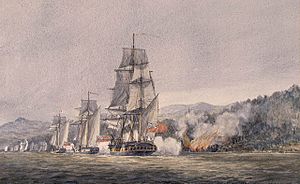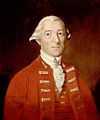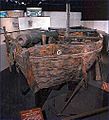Battle of Valcour Island facts for kids
The Battle of Valcour Island was a big naval fight. It happened on October 11, 1776. This battle took place on Lake Champlain in New York. It was one of the first naval battles of the American Revolutionary War. The main fight was in Valcour Bay, near Valcour Island. American ships, led by Benedict Arnold, fought against British forces. The British were led by General Guy Carleton. The British wanted to move south into the Hudson Valley. But the American defense on Lake Champlain stopped them. This battle slowed down the British plans.
Quick facts for kids Battle of Valcour Island |
|||||||
|---|---|---|---|---|---|---|---|
| Part of the American Revolutionary War | |||||||
 Royal Savage is shown run aground and burning, while British ships fire on her (watercolor by unknown artist, ca. 1925) |
|||||||
|
|||||||
| Belligerents | |||||||
| Kingdom of Great Britain | |||||||
| Commanders and leaders | |||||||
| Benedict Arnold | Guy Carleton Thomas Pringle |
||||||
| Strength | |||||||
| 15 armed ships 500 sailors |
25 armed ships 697 sailors 1,000 soldiers 650 Indians |
||||||
| Casualties and losses | |||||||
| 80 killed or wounded 120 captured 11 ships lost |
40 killed or wounded 3 small gunboats lost |
||||||
Contents
Why the Battle Happened
In June 1776, the Continental Army moved. They left Quebec and went to Fort Ticonderoga and Fort Crown Point. They spent the summer making their forts stronger. They also built more ships for their army.
British Plans
General Carleton had a large army of 9,000 soldiers. They were at Fort Saint-Jean. But he needed a way to move them across Lake Champlain. The Americans had either taken or destroyed most of the ships on the lake. This meant the British had to build their own fleet.
The Battle on Lake Champlain
On October 11, Benedict Arnold led the American ships. He chose a spot that made it hard for the British to attack. This gave the Americans some advantages. During the battle, many American ships were damaged or destroyed.
Arnold's Escape
That night, Arnold bravely led the American ships past the British. They sailed towards Crown Point and Ticonderoga. But the weather was bad. More American ships were captured or burned before they reached Crown Point. When Arnold got to Crown Point, he burned the fort's buildings. Then he left for Ticonderoga.
After the Battle
Even though the Americans lost many ships, the battle was important. It slowed down the British army. This delay meant the British could not reach the Hudson Valley that year. This gave the Americans more time to prepare their defenses.
Important Places Today
Valcour Bay, where the battle happened, is now a National Historic Landmark. The USS Philadelphia was an American ship that sank during the battle. It was brought up from the lake in 1934. The USS Spitfire was found in 1997. Both ships are important historical sites.
Images for kids
-
Quebec's Governor, General Guy Carleton
-
The Philadelphia was raised in 1935. It is now in a museum.
See also
 In Spanish: Batalla de la isla Valcour para niños
In Spanish: Batalla de la isla Valcour para niños







